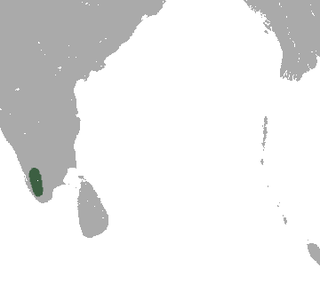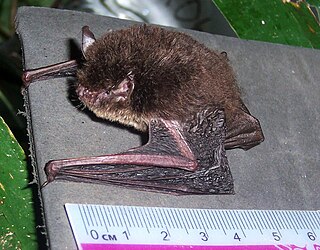
The serotine bat, also known as the common serotine bat, big brown bat, or silky bat, is a fairly large Eurasian bat with quite large ears. It has a wingspan of around 37 cm (15 in) and often hunts in woodland. It sometimes roosts in buildings, hanging upside down, in small groups or individually. The name serotine is derived from the Latin serotinus, which means 'evening', while the generic name derives from Greek ἔπιεν and οίκος, which means 'house flyer'.

Salim Ali's fruit bat is a rare megabat species in the monotypic genus Latidens. It was first collected by Angus Hutton, a planter and naturalist in the High Wavy Mountains in the Western Ghats of Theni district, Tamil Nadu in South India in 1948. It was initially misidentified as a short-nosed fruit bat (Cynopterus) but later identified by Kitti Thonglongya as a new species and was named after Indian ornithologist Salim Ali in 1972.

Kelaart's pipistrelle is a species of vesper bat found in southern and south-eastern Asia from Pakistan to Indonesia.

The least pipistrelle is a species of vesper bat.

The greater Asiatic yellow bat is a species of vesper bat. It is found in Afghanistan, Bangladesh, Cambodia, China, India, Indonesia, Laos, Myanmar, Nepal, Pakistan, Philippines, Sri Lanka, Thailand and Vietnam.

The lesser Asiatic yellow bat is a species of vesper bat. It is found in Bangladesh, India, Indonesia, Malaysia, Pakistan, the Philippines, Sri Lanka, and Taiwan.

The chocolate pipistrelle is a species of vesper bat in the family Vespertilionidae. It is found in China, India, Myanmar, Nepal, and Sri Lanka.

Bechstein's bat is a species of vesper bat found in Europe and western Asia, living in extensive areas of woodland.

The wall-roosting mouse-eared bat, or Nepalese whiskered myotis is a species of vesper bat whose type locality is Nepal.

Welwitsch's bat also known as Welwitsch's mouse-eared bat or Welwitsch's myotis is a species of vesper bat native to Africa.

The chestnut sac-winged bat, or Wagner's sac-winged bat is a species of sac-winged bat native to South and Central America. It is the only species within its genus.

The black-bearded tomb bat is a species of sac-winged bat found in South and South East Asia.

The Khajuria's leaf-nosed bat, also known as Durga Das's leaf-nosed bat, is a species of bat in the family Hipposideridae. It is endemic to India. Its natural habitat is caves. It is threatened by habitat loss.

The Cuban fig-eating bat, or white-shouldered bat, is a species of bat in the family Phyllostomidae, found only in the Caribbean. It is the sole extant species in the genus Phyllops, although two other species, P. vetus and P. silvai, are known from fossils.

The lesser woolly horseshoe bat, also called Beddome's horseshoe bat, is a species of bat in the family Rhinolophidae. It is found in India and Sri Lanka. Its natural habitats are subtropical or tropical moist lowland forests, caves, and urban areas.

The convex horseshoe bat is a species of bat in the family Rhinolophidae. It is found in Malaysia and Laos.

The small mouse-tailed bat is a species of bat in the Rhinopomatidae family. It is found in Afghanistan, Iran, Oman, and possibly Ethiopia. The small mouse-tailed bat ranges from the Sistan Basin in Iran well into the Helmand River basin of south-western Afghanistan.

Hesperoptenus is a genus of bats within the Vespertilionidae or vesper bat family.

Eptescini is a tribe of bats in the family Vespertilionidae. This tribe has a cosmopolitan distribution.





















